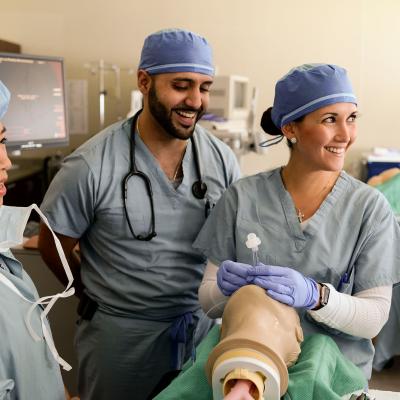- AdventHealth University

In today’s brave new world of healthcare innovation and ever-changing delivery models, communication is key. Healthcare professionals must master the art of collaboration and learn effective strategies for communicating not only with patients and their families but also with the multiple layers of healthcare providers. To communicate effectively, members of the healthcare team must learn and implement numerous methods of interpersonal communications.
Why We Need Interpersonal Sensitivity and Improved Communication
Better communication between patients and healthcare providers are correlated with improved patient outcomes.1 With the current emphasis in healthcare promoting overall wellness, healthcare professionals should seek to expand their interpersonal skills for the benefit of their patients. This would ensure patients have a positive experience and promote better patient outcomes and satisfaction. Too often, people (healthcare professionals included) believe that being “good with people” is an innate talent like the ability to sing well or being a gifted athlete when the reality is that good interpersonal skills can be taught to anyone.
Barriers to Good Interpersonal Communication
When addressing the importance of interpersonal skills and effective communications, it’s important to keep in mind potential barriers – especially in medical and healthcare settings. Barriers to effective interpersonal communication begin with the very core of providing healthcare, the subject matter, and setting. Medical care involves the delivery of complex information and to make matters worse, medical settings are, by their very nature, intimidating to patients.
Another obstacle to effective communication is the rapidly changing healthcare environment, which can make it more difficult for patients to discuss illness and complaints. While healthcare has shifted to empower patients to take ownership of their health, doing so can be difficult if they don’t have a full understanding of the communication channels.
Perhaps the most significant impediment to effective communication is the emotional intelligence of healthcare workers. Emotional intelligence is the ability to recognize emotions in themselves and others and to use this knowledge to help patients both feel at ease asking questions and better understand the answers they’re given. While most healthcare professionals choose their careers based on a sincere desire to help people, too often the skills and knowledge valued in the educational and training process are heavily skewed toward mastering information. Healthcare professionals would be well-served by taking classes aimed at improving their interpersonal sensitivity and enhancing their ability to communicate with patients.
Tips for Better Interpersonal Sensitivity in the Healthcare Setting
1. Build Good Rapport as Soon as Possible
Part of establishing rapport is setting the patient at ease or being sure they are comfortable talking to you. Another important part of this initial connection is ensuring the agenda is set for the appointment or encounter in a way that puts the patient in control. Learning how to ask open-ended questions and to reflect what the patient has said are key to ensuring that healthcare providers are addressing the true concerns of patients rather than just the concerns that the patient brought up or feels safe discussing.2
To get a complete picture of patient concerns and symptoms, healthcare providers must set the stage in a way that encourages the patient to talk openly. Healthcare professionals must also respond in ways that confirm information, but more importantly, let the patient know they have been heard and encourage them to continue sharing relevant information. Ask “What questions do you have for me?” to ensure that the patient the opportunity to receive clarification.
2. Listen to and Understand the Patient’s Perspective
Healthcare providers have many competing priorities when working with patients. First and foremost, healthcare professionals must provide accurate and effective care. Beyond that, assessing patient status, changing situations and needs, and accurately recording vital data are just a few other issues that must be addressed. It can be difficult to add listening to the patient’s perspective to the mix, especially since time may be limited. However, even a few minutes of significant interpersonal connection may be key to the success of all the other medical assessments you are providing. Making sure the patient is heard and acknowledged is as important as accurately recording vital signs or performing a physical assessment.
By practicing active listening, healthcare professionals can ensure patient concerns are heard, noted, and addressed. Active listening involves giving the patient your undivided attention while they are speaking and responding to them with words that both validate that you were listening and that seek to clarify an understanding of the patient’s experience.3 Something as simple as replying with “It sounds like you…” or “I hear you saying…” can encourage patients to confirm or clarify their experience and can lead to a deeper rapport.
3. Demonstrate Empathy
Demonstrating empathy lets the patient know that they have been heard and that you, as the healthcare professional and provider, understand his or her concerns. There are easy ways to demonstrate empathy in addition to active listening. Asking about the patient’s comfort and addressing any discomfort they express is important. Is your patient cold, in pain, or frightened? Can you alleviate the situation? If not, you can express your understanding of his or her discomfort and explain when and how the discomfort will end. Acknowledge their issue or concern promptly and be mindful of your phrasing. Say “I’m sorry that happened,” not “I’m sorry you feel that way.” Never forget how it feels to be in a strange setting, stripped of much of what makes you an individual, and hearing words or phrases that may be foreign to you.
4. Collaborate for the Best Result
Once you have established rapport, acknowledged the patient’s perspective, and demonstrated your empathy or understanding, work to collaborate with the patient. Try to avoid giving orders and making the patient feel as if he or she has no control. The goal is to work with the patient and provide choices whenever possible. For example, if an imaging procedure can be performed with the patient standing or laying down on a table, let him or her choose the method that is most comfortable. For a procedure that will take several steps, explain to the patient how he or she can work together with you to make the procedure go smoothly, perhaps even faster. Ensure that directions are simple and easy for the patient to understand.
Communicating with Pediatric Patients
These tips are essential when working with any patient, but even more so when working with pediatric patients. It’s important to adapt your interpersonal communication skills to children. 4
The medical setting can be especially frightening for children. When working with pediatric patients, engaging them and making them feel comfortable is a priority. Not only will this make the exam or procedure go more smoothly, but it will help the child feel more at ease in future medical settings.
When working with children, you can build rapport and help them feel comfortable with simple things like smiling, knowing their names, getting on their level physically, and explaining what they can expect using age-appropriate language.
Another helpful tip for building an interpersonal connection with children is creating a playful setting. Wear colorful clothes, have toys or books available, and give kids rewards like stickers or stuffed animals. Also, be sure to include the child when talking about them to caregivers and parents.
Interpersonal Skills Can Be Taught
When considering advancing your career in healthcare, choose educational programs that stress a wholistic approach to healthcare and emphasize treating the entire person. Look for nursing, imaging technology, and healthcare administration programs that integrate interpersonal relationship skills into the curriculum.
Learn more here about how AHU Online prepares you to serve and helps you reach your healthcare career goals.
Sources:
- Calvin Chou, “Time to Start Using Evidence-Based Approaches to Patient Engagement,” New England Journal of Medicine, March 28, 2018, https://catalyst.nejm.org/evidence-based-patient-provider-communication/.
- Laurence H. Baker, Daniel O’Connell, PhD, and Frederic W. Platt, “’What Else?’ Setting the Agenda for the Clinical Interview,” Annals of Internal Medicine, November 15, 2005, http://www.hadassah-med.com/media/2003590/02WhatElseSettingtheAgendafortheClinicalInterview.pdf.
- Vahid Kohima Jahrom, “Active listening: The Key to Successful Communication in Hospital Managers,” Electronic Physician, March 8, 2016, doi: 10.19082/2123.
- Cristina Oana Mărginean et al. “Communication skills in pediatrics – the relationship between pediatrician and child,” Medicine (Baltimore) 96, no. 43 (2017): e8399, doi: 10.1097/MD.0000000000008399.


